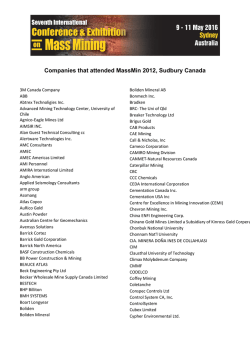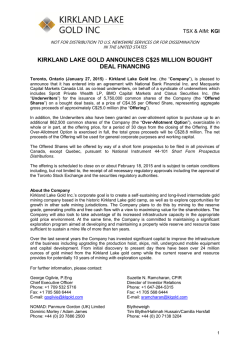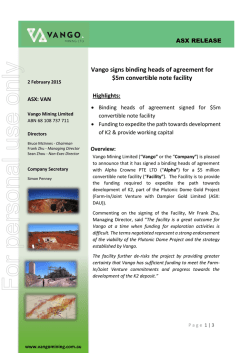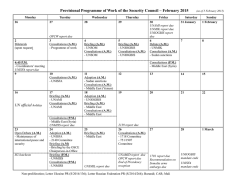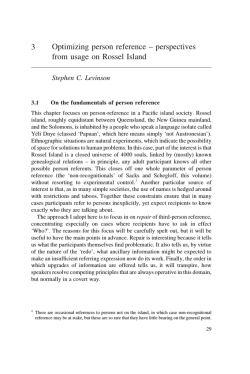
Inside Briefing Interview
Attention: ASX Company Announcement Platform Lodgement of Inside Briefing – 27 January 2015 For personal use only The Company Announcements Officer Australian Securities Exchange Ltd via electronic lodgement The following is an Inside Briefing interview with Kin Mining Managing Director, Mr Trevor Dixon In this interview, Trevor Dixon provides an update on emerging Australian gold company Kin Mining NL (ASX: KIN – market capitalisation: ~$7.3 million at 15c; 48.3M shares on issue) and its plans to develop a substantial gold business based on its recently acquired Leonora Gold Project in Western Australia. Highlights of this interview include: Kin’s counter-cyclical acquisition of the advanced Leonora Gold Project (LGP), which has a large gold resource inventory and over $20 million of historical exploration expenditure. Kin acquired this asset from the Administrator of Navigator Resources for the equivalent of $2.60 per resource ounce; The rich history of gold mining in the Leonora region, the status of the large LGP resource inventory and Kin’s plans to upgrade this to JORC 2012 compliance; and The Company’s plans to target near-term cash-flow through a production opportunity at the Lewis pits, within the Cardinia resource and its broader strategy to advance the LGP towards a Feasibility Study and wider development; The substantial exploration potential of the Leonora field, particularly at depth, and the Kin Mining team’s plans to unlock this potential – leveraging off its extensive experience in the area. Inside Briefing: Kin Mining acquired the 745,000oz Leonora Gold Project last year from the Administrators of Navigator Mining. What are the main attributes of the Leonora Project and why was this an attractive deal for Kin? Trevor Dixon: Our team is very excited to have secured the Leonora Gold Project (LGP) asset. It enhances our exposure in the Leonora district, complementing our existing holdings in a region that has produced in excess of 15 million ounces of gold. The acquisition of the LGP has transformed Kin from a junior explorer to an emerging producer within just over a year. The main attribute of the LGP purchase is the large gold resource – gold being our principal commodity. I believe that we have been able to secure these gold resource ounces at, or close to, the bottom of this current gold cycle. The project has accrued in excess of $20 million of exploration expenditure, which has crystallized and advanced this development opportunity. You cannot drill, assay, calculate a resource, complete a pre-feasibility study and trial mine for anything near the low price that Kin has paid for these proven resource ounces. If we were to start from scratch, the cost for the LGP would be around $20-25 per ounce. Kin’s acquisition price was just $2.60/oz. We believe that we have de-risked our exploration exposure by purchasing the high quality Mertondale/Cardinia resources at a rock bottom price. The asset gives the Company a great start considering we have only been listed 16 months and a robust gold inventory with upside that has not been fully evaluated. Inside Briefing | Kin Mining NL | TBA December 2014 Attention: ASX Company Announcement Platform Lodgement of Inside Briefing – 27 January 2015 Inside Briefing: What is the mining and production history of the Leonora Project? Can you provide a brief overview of the existing JORC Mineral Resource inventory? How does it compare to other gold projects at a similar stage of development in Australia? How much work is required to convert this resource to JORC 2012 compliance? For personal use only Trevor Dixon: The mining centres contained within the Leonora Gold Project have a long and rich history of discovery and production. Gold was first discovered as early as 1899 at Merton’s Reward – the richest gold mine in the district. At the turn of the 20th century, the head grade at Merton’s Reward was 8oz/t. It averaged 20g/t over its life for production of 60,524oz of gold. During the 1980s, Hunter Resources and Ashton Mining drilled out and mined several ore deposits around the Mertondale area, culminating in the production of more than 5.5 tonnes of gold between 1986 and 1991. High grade gold production has historically been achieved from Merton’s Reward, Cardinia, Gambier Lass, and Forgotten Four. Since then the main mining occurred north of Merton’s Reward in the 1970s and 1980s at Mertondale 3/4 and 5. Following this the area has undergone extensive exploration by numerous exploration companies to generate the current JORC 2004 resource base of 745,000oz at 1.9g/t Au. A further 282,000oz Au has been identified and sits outside the resource. We firmly believe that there are more ounces to be discovered in the district which will complement our existing gold inventory. The current gold inventory is in excess of one million ounces in one of the few old mining areas in the Eastern Goldfields – if not the state – that has not had any significant underground development let alone deep exploration drilling. The LGP compares extremely well with other gold projects at a similar stage of development in Australia as the large resource base lies within near-surface pit shells which are amenable to low cost open cut mining methods. I can’t think of too many companies that have three quarters of a million ounces of gold in the ground at good grade and they’re not mining it, so I think we are in a strong position going forward. The resources are JORC 2004 compliant and Kin is advancing the resources to comply with JORC 2012 Code. However, it is worth noting that a year or two ago JORC 2004 was perfectly acceptable many mines have quoted and operated under the JORC 2004 classification for the past decade. JORC 2012 is simply full disclosure of all geological data and findings with increased Quality Assurance and Quality Control parameters. In my opinion, the ounce count would remain the same under both classifications. Kin has not conducted any additional exploration that would materially change the original resource outcomes. In relation to conversion to JORC 2012, this is a process that is advancing well. Our geological team has compiled most of the metadata required for the conversion, and the next step is to have the resources reviewed by an independent source. We anticipate this to be a seamless exercise as this process has already been undertaken as part of the Pre-Feasibility stage by the previous owner. There has been no material change to the resources, so we expect the resources in the 2012 category to be nearly the same. Inside Briefing: Just before Christmas, Kin said it had identified a near-production opportunity based on high-grade start-up open pits at Lewis, within the Cardinia resource, and using on-site leaching as a rapid and low cost treatment option. Can you provide a bit more detail about this development strategy in terms of indicative capital requirements, production scale and timeline to first production? Trevor Dixon: We are very excited about this development and we see it as a strategic opportunity to generate cash flow at a time of an improving gold price. Initial capital requirements have been dramatically reduced due to the well advanced nature of the project as the drilling and mine designs have already been completed. Inside Briefing | Kin Mining NL | TBA December 2014 Attention: ASX Company Announcement Platform Lodgement of Inside Briefing – 27 January 2015 Approval for a mining proposal at Lewis was granted to the previous owner and subsequently withdrawn prior to the Company entering into Administration. Currently, an amended Mining Proposal is being considered for Departmental approval allowing for the leaching treatment option to be included. For personal use only We are currently completing some final metallurgical test-work to confirm recovery rates of the ore and we also are in discussion with earthmoving contractors to finalise the budget of the first phase of the project. We plan to stage the production to reduce initial capital expenditure of the project. The two (East and West) Lewis pits are positioned within the larger Lewis resource and leaching provides an effective method of extracting the gold in this free dig scenario. By doing this, we will get a better understanding of the ore and what areas of the resource will be amenable to this mining technique. The indicative capital requirements of the first stage of production to mine and treat the first 50,000 tonnes of ore at Lewis is in the order of A$1 million. Historical rates of recovery from metallurgical testing of the Lewis ore has indicated a 70% recovery rate. Our management team intends to take a cautious approach by basing the budget calculations on a more conservative 50% recovery rate and we have determined that, even if a recovery rate as low as 24% was achieved, the project would still break even. At today’s gold price of around A$1500.00 per ounce, and a recovery rate of 50% from the 50,000t of ore which has an average head grade of 2.17 g/t (1,744oz), the first stage of the project has the potential to generate gross income in the order of $2-3 million. We envisage that we could be into production in the second half of this year. The planned second stage production at Lewis involves an additional 130,000 tonnes of ore at an average head grade of 2 g/t. This part of the production profile will follow stage 1 at Lewis. Inside Briefing: What is your broader development strategy for the Leonora Project? What are the next steps for the project in terms of Feasibility Studies, financing, permitting and development? Trevor Dixon: The LPG is a robust platform that enables Kin to enter into production in a short period of time. The Lewis mining exercise should put Kin in a strong cash positive position, enabling us to advance our broader development strategy for the project. The well advanced nature of the resource base at Leonora puts Kin in a fortuitous position with most of the heritage surveys, environmental studies and pre-feasibility studies already complete for the existing resources. Therefore, as we progress through the initial mining stages, the transition into larger scale production should have a reduced time lag. We plan to upgrade the existing resources to JORC 2012 and conduct deeper drilling underneath and surrounding the existing deposits to determine the lateral extent of the ore zones, which are mostly open at depth and along strike. Although our management team would like to commission a Feasibility study for the LGP sooner rather than later, we need to advance the project at a pace that suits our available resources. Therefore, we have decided to wait until we have generated some cash flow or the market conditions improve before committing to the expense of a Feasibility Study, which is not inconsiderable. Project financing will predominantly come from cash flow derived from gold production or, if favourable market conditions return, we may return to the equity market for funding. Eventually we aim to be in a position where we have generated an income, upgraded the resources to 2012 JORC compliance and advanced the project to a level where we can raise money to build an independent processing plant and develop the resources, but at the same time still explore and replenish the ore stocks as we mine them. Inside Briefing | Kin Mining NL | TBA December 2014 Attention: ASX Company Announcement Platform Lodgement of Inside Briefing – 27 January 2015 Inside Briefing: What other deposits and/or target areas present as priority development/production areas? Where are the most prospective opportunities to grow the resource base in future? How do you rate the potential for future underground mining in this region? For personal use only Trevor Dixon: One of the most appealing aspects of the LGP is the exploration upside of the district. Although the current resources are well defined, the ground along strike and below these known mineralised corridors require extensive exploration. Mert’s Reward for example has not had any modern day mining activities since the 1940’s with most of the gold extracted with pick and shovel at the turn of the 1900’s. This is an interesting fact when you consider how rich this deposit was, and the limited amount of exploration that has taken place south of the deposit and at depth. There also remains considerable upside at the Cardinia supergene resource as this supergene blanket has not been closed off to the east, west or the north. The question of the source of this supergene enrichment still remains, to date there is no identifiable primary source to explain the gold enrichment. With the very limited drilling undertaken below the supergene blanket, there is considerable potential to discover more mineralisation at depth. The priority at the moment is targeting shallow surface deposits that lend themselves to open cut mining and heap leaching – effectively fast, easy money in mining terms. We are still evaluating the Navigator database and determining the best deposits to explore, either along strike or at depth. Initial investigations indicate that Tonto is a stand-out deposit that has depth potential, however deep diamond drilling is expensive and Kin has numerous ore deposits in the LGP to evaluate as well as several relatively unexplored areas that have returned economic numbers within our pre-existing tenement holdings. So prioritising targets and evaluating potential production opportunities will keep our geologists busy for some time yet! Potential underground deposits are certainly on the agenda, however, we believe that the best and easiest places to delineate ounces are in an areas that have already displayed mineralisation or are near mine. Therefore drilling under existing deposits to determine both depth potential and closing off strike extensions to the existing pit shells remain our key exploration priorities. The LGP has never had any underground development, apart from the original Merton’s Reward. Almost every other mining camp in WA displaying this volume of past production now has an underground mine within it. The other point I would like to make is that the same amount of cash can be generated from several small to medium sized mining operations as compared to one large operation. Inside Briefing: Kin has been drilling prospective nickel targets at the Kingfisher prospect. What is the status of this exploration and what further regional exploration work is planned in 2015? Trevor Dixon: Kingfisher is an exciting prospect that has historically returned economic copper, platinum and nickel grades. We are still actively exploring the prospect. The geophysical results returned so far have identified at least two electromagnetic (EM) conductors. The right rocks are present and we have received some encouraging drill results, but it is important to remember that nickel sulphide deposits are very difficult to locate. Further deep +300m drilling is planned along with some down-hole IP geophysics. It is early days, but results to-date are very encouraging. Exploration at Kingfisher is continuing. Another interesting area is along the Gwalia Shear Zone (GSZ) where further exploration is scheduled for this year. Kin holds 26 contiguous kilometres of strike immediately south of the Sons of Gwalia mine. Numerous ore bodies have been discovered north of Sons of Gwalia, all the way to Thunderbox, but Inside Briefing | Kin Mining NL | TBA December 2014 Attention: ASX Company Announcement Platform Lodgement of Inside Briefing – 27 January 2015 following the same structure and the same geology south reveals only small workings and prospector pits due to the extensive regolith cover. We believe the granite greenstone contact and the GSZ south of Leonora have enormous exploration potential. For personal use only Inside Briefing: Can you give us some background about the key members of your team and what their historical connection is to the Leonora region? How would you summarise your vision for Kin and what are the key elements of the Kin investment proposition? Trevor Dixon: Kin has assembled a team of experts who have all done the “hard yards” in the Eastern Goldfields, particular the Leonora district. Our footprints are all over that country and the reason we keep going back there is because it is just good gold country – ask any Prospector/Geologist about the mineralisation potential of the Eastern Goldfields, particularly Leonora. My connection with this region goes back to the early 1980’s where my first involvement with mining was shaft -sinking and putting ore parcels through the State Battery for treatment. During the late 1980’s and early 90’s, I spent four years carrying out multiple heap leach operations within the district, honing my gold recovery skills. I established an earthmoving business to service the emerging gold industry at that time, whilst identifying and securing areas of prospective mineral significance. I then sold or joint ventured these areas into the junior IPO gold market or established mining companies. Kin’s Chairman is Terry Grammer, a very experienced geologist who was awarded the Prospector of the Year in 1998 for his part in the discovery of the Cosmos Nickel Deposit. Terry was a founding member of Western Areas NL, who are successfully mining nickel from the Forrestania region, and he currently sits on the Board of Sirius Resources, which is developing the Nova nickel deposit. His experience of taking a deposit into production will be invaluable for Kin going forward. Fritz Fitton is the Technical Director who has spent numerous years exploring the Leonora district for the likes of Triton/Sabre Resources and Esso Minerals, where he discovered the Harbour Lights deposit at Leonora. Fritz also has several large discoveries under his belt including the Raeside deposits which form part of the LGP. Joe Graziano is the Company Secretary and a Charted Accountant with 25 years’ experience providing a wide range of business, financial and taxation advice to small cap unlisted and listed public companies as well as privately owned businesses in Western Australia’s resource-driven industries with turnover ranging from $25 million to $250 million. He has extensive knowledge and experience in corporate advisory and strategic planning with public companies and private businesses going through a rapid growth phases, including experience in capital raisings, ASX compliance and regulatory requirements. The geological team consists of Paul Maher, our Senior exploration geologist who has 30-plus years’ experience and he actually worked on the Mertondale project in the late 1980’s and has had extensive exposure to the Eastern Goldfields, along with Simon Buswell-Smith, who worked for Navigator Exploration for five years and has a wide range of experience and local knowledge regarding the LGP area. Our vision quite simply is to create a stand-alone gold producer, although other commodities are also of interest to us. I believe that we have the potential be one of Australia’s’ lowest cost producers. Inside Briefing | Kin Mining NL | TBA December 2014 Attention: ASX Company Announcement Platform Lodgement of Inside Briefing – 27 January 2015 Kin is in control of a significant gold resource in a well-endowed region that has close proximity to supporting infrastructure at Leonora including rail, road, airport and the Kalgoorlie gas pipeline for any proposed mining operations. For personal use only The capital structure remains tight for a Company with this many ounces in its inventory and this can be attributed to our loyal shareholders who share the vision of our management team for the development of the resources at Leonora. The Management group holds almost 30% of the Company, so this should give confidence to future Investors that Management is fully engaged and has “skin in the game.” Our mantra is, quite simply, “Discover, Develop and Deliver”. Inside Briefing: Thank you, Trevor. ENDS Further information: Investors/Shareholders: Kin Mining NL Trevor Dixon T: +61 8 9242 2227 E: [email protected] Investor Relations/Media: Nicholas Read / Paul Armstrong Read Corporate T: +61-8 9388 1474 M: (0419) 929 046 E: [email protected] Important Notice: Read Corporate has taken care in the provision of assistance to compile and publish this information on behalf of Kin Mining in good faith and as agent of Kin Mining for the purpose of providing the information to the ASX and those to whom it is published by the ASX. Read Corporate makes no warranties as to the accuracy of any facts or representations contained in the information, and has relied upon information provided to it in publishing this material to the ASX. Read Corporate does not accept any responsibility for any opinions expressed in the information or material. Read Corporate is not a financial adviser and this information and material is not financial or other advice of any type whatsoever. Subject to any terms implied or imposed by law and which cannot be excluded, Read Corporate is not responsible for any reliance, loss, damage, cost or expense incurred by any reliance upon this information and material or by acting upon it or for any error, omission or misrepresentation conveyed. This information is general only and does not take into account any individual objectives of investors. Read Corporate encourages the reader to read the full ASX announcements published by Vital Metals. Professional advice should be taken before making investment decisions. Forward-Looking Statements: This Inside Briefing includes “forward-looking statements” as that term within the meaning of securities laws of applicable jurisdictions. Forwardlooking statements involve known and unknown risks, uncertainties and other factors that are in some cases beyond Kin Mining’s control. These forward-looking statements include, but are not limited to, all statements other than statements of historical facts contained in this presentation, including, without limitation, those regarding Kin Mining’s future expectations. Readers can identify forward-looking statements by terminology such as “aim,” “anticipate,” “assume,” “believe,” “continue,” “could,” “estimate,” “expect,” “forecast,” “intend,” “may,” “plan,” “potential,” “predict,” “project,” “risk,” “should,” “will” or “would” and other similar expressions. Risks, uncertainties and other factors may cause Kin Mining’s actual results, performance, production or achievements to differ materially from those expressed or implied by the forward-looking statements (and from past results, performance or achievements). These factors include, but are not limited to, the failure to complete and commission the mine facilities, processing plant and related infrastructure in the time frame and within estimated costs currently planned; variations in global demand and price for tantalum and lithium; fluctuations in exchange rates; failure to recover the resource and reserve estimates of the Project; the failure of Kin Mining’s suppliers, service providers and partners to fulfil their obligations under construction, supply and other agreements; unforeseen geological, physical or meteorological conditions, natural disasters or cyclones; changes in the regulatory environment, industrial disputes, labour shortages, political and other factors; the inability to obtain additional financing, if required, on commercially suitable terms; and global and regional economic conditions. Readers are cautioned not to place undue reliance on forward-looking statements. We assume no obligation to update such information. The information concerning production targets in this announcement are not intended to be forecasts. They are internally generated goals set by the board of directors of Kin Mining. The ability of the company to achieve these targets will be largely determined by the company’s ability to secure adequate funding, implement mining plans, resolve logistical issues associated with mining and enter into off take arrangements with reputable third parties. Inside Briefing | Kin Mining NL | TBA December 2014 Attention: ASX Company Announcement Platform Lodgement of Inside Briefing – 27 January 2015 Competent Person’s Statement: For personal use only The information in this report relates to Exploration Results based on information compiled by Paul Maher who is a member of the AusIMM and an employee of the company and fairly represents this information. Mr Maher has sufficient experience of relevance to the styles of mineralisation and the types of deposit under consideration, and to the activities undertaken to qualify as a Competent Person as defined in the 2012 edition of the JORC Australian code for reporting of Exploration Results, Mineral Resources and Ore Reserves. Mr Maher consents to the inclusion in the report of the matters based on information in the form and context in which it appears. Inside Briefing | Kin Mining NL | TBA December 2014
© Copyright 2025
